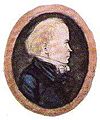
Swedish Romantic literature denotes Swedish literature between 1809 and 1830.[1] In Europe, the period from circa 1805–1840 is known as Romanticism. It was also strongly featured in Sweden, based on German influences. During this relatively short period, there were so many great Swedish poets, that the era is referred to as the Golden Age of Swedish poetry.[2][3] The period started around 1810 when several periodicals were published that contested the literature of the 18th century. An important society was the Gothic Society (1811), and their periodical Iduna, a romanticised retrospect to Gothicismus.[2]
One significant reason was that several poets for the first time worked towards a common direction. Four of the main romantic poets that made significant contributions to the movements were: the professor of history Erik Gustaf Geijer, the loner Erik Johan Stagnelius, professor of Greek language Esaias Tegnér and professor of aesthetics and philosophy P.D.A. Atterbom.[4]
Geijer (1783–1847) was one of the earliest and most prominent members of the neo-gothicist Gothic Society. As a professor he published two cultural-historical works: "Svea rikes hävder" and "Svenska folkets historia", where he gave support to the idea of the Viking Age being a cultural height that was suppressed during the Middle Ages.[5][6] Stagnelius (1793–1823) spent his short adult years living as an outsider in Stockholm. Many of his poems deal with the beauty in nature, encompassing the loneliness of the soul, and it is both for his beauty and his mysticism that Stagnelius's works were to attain recognition.[7] The fame of Atterbom (1790–1855) comes from his flower poetry: Lycksalighetens ö ("Island of Bliss"), 1824–1827, and a collection of poetry called Blommorna.[8]
Esaias Tegnér (1782–1846) has been described as the first modern Swedish man, in the sense that very much is known about both his life and his person, and that he left an extensive correspondence. His greatest success was Frithiof's Saga (1820–1825), a romanticized version of the Icelandic sagas but in a modern dress. The work was translated into several languages, put to music in Sweden, where it had status of a national epos until the realism of the 1880s obsoleted it.[9]
-
Atterbom, 1831
-
Geijer
-
Stagnelius, posthumous medallion
© MMXXIII Rich X Search. We shall prevail. All rights reserved. Rich X Search



